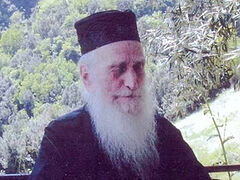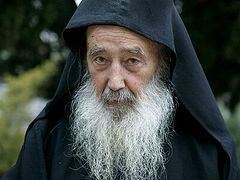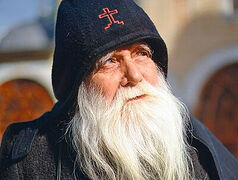For the 20th anniversary of the repose of the holy and Venerable Dionisie of Romania and Mt. Athos (1909–2004), who will be canonized in 2025.
The following article was originally published in “Familia Ortodoxa” No. 5 (64), May 2014.
***
An elder from Holy Mount Athos, from the mountain of prayer, the mountain of repentance, the mountain of tears, the mountain of ascetic labors, where the image of the Most Holy Theotokos reigns; from the mountain where, as someone once said, not a single man is born, but where they come to die—to sin, to the passions, to the lusts, ambitions, and vexations of this deceptive world, in order to ascend to where the glory of the world to come, the Kingdom of God, shines.
This is how Archimandrite Ephraim of Vatopedi describes the spiritual portrait of Elder Dionisie from the Colciu Skete.1
Elder Dionisie is a great Romanian spiritual father, revered by Athonite ascetics of all nationalities who inhabit the Garden of the Most Holy Theotokos. News of his holiness spread beyond Athos, and the old abba was visited in great number by hierarchs, priests, monks, and laymen, who asked him, as in the Paterikon, to give them “a word for the salvation of their souls.” And his main word, especially in his last years, was the following:
“We have to have spiritual friendship, for that’s love, and where there is love, there is God. And where there is no love, there is no God.”
Fr. Dionisie was an “old-fashioned” monk who tried all his life to adhere to the traditions he received from the elders and to pass them on to his disciples and spiritual children, for all seventy-seven years of his monastic labor.
“We left everything we had and didn’t have in order to find holy salvation”
 The Church of St. George in Suceava, where the holy relics of St. John the New are kept. Photo: visitingbucovina.ro
The Church of St. George in Suceava, where the holy relics of St. John the New are kept. Photo: visitingbucovina.ro
The youngest child from the large Ignat family, which lived in the village of Vorniceni in Botoșani County, in Holy Baptism he received the Holy Great Martyr Demetrius as his patron saint. And at the age of two, God permitted that he lose his father.
 Hieroschemamonk Dionisie (Ignat) and Monk Ioan (Sova) Monk Ioan (Sova), who knew Fr. Dionisie well, said:
Hieroschemamonk Dionisie (Ignat) and Monk Ioan (Sova) Monk Ioan (Sova), who knew Fr. Dionisie well, said:
Their father was a very pious man; he and his whole large family often went on pilgrimage to the nearby monasteries together. Here’s a vivid example of his great faith. Once he went to venerate the holy relics of the Great Martyr John the New of Suceava, but he didn’t know the way and he asked everyone he met. But after a while, when he was still three to four hours away from Suceava, he smelled the fragrance of holy myrrh. He followed this fragrance, and found that it led him directly to the relics of St. John.
As the saying goes, “The apple doesn’t fall far from the tree.” This folk wisdom was fully confirmed by the Ignat family, where the children absorbed the spirit of reverence from an early age and tried to go to church and labor in prayer, come what may. The elder brother was the first to go to a monastery, at Magura Skete, and through him God poured the sweetness of monastic labor into the soul of his younger brother.
 Magura Skete, 1945. Photo: Wikipedia
Magura Skete, 1945. Photo: Wikipedia
And so, in 1926, in the midst of the troubles caused by the calendar change, with the Church switching to the new style, young Dimitrie, who was only seventeen, together with his older brother Hierodeacon Gimnazie, left for the Holy Mountain. They had little idea what awaited them there, but they were burning with the fire of God’s call:
From the moment we arrived on the Holy Mountain, the Fathers always sought holy salvation; after all, that’s why we left our dear and beloved homeland, mother, father, and everything someone could have or not have—to find holy salvation.
In Constanța, they boarded a magnificent Romanian ship and arrived in Piraeus. They spent three days there then boarded a small, fragile boat, fiercely beaten by the waves. After long adventures, bypassing many islands, they reached Holy Mount Athos at the port of Daphne, where, to their joy, they found bread,
said Fr. Ioan (Sova).
 Cell of St. George at Kapsala Skete. Photo: ziarullumina.ro
Cell of St. George at Kapsala Skete. Photo: ziarullumina.ro
“First, we went to the Cell of St. George in Kapsala. There were eighteen Romanians there. We arrived on the eve of the feast of the Nativity of the Most Holy Theotokos and immediately stayed for the All-Night Vigil,” recalls Fr. Dionisie about his arrival to Mt. Athos.
“On the Holy Mountain, my soul felt contented, like nowhere else”
 Elder Dionisie at the Hermitage of St. John the Baptist
Elder Dionisie at the Hermitage of St. John the Baptist
“The Holy Mountain is called the Garden of the Mother of God, and rightly so, because the Mother of God came here for the first time and blessed this place, and then the locals became Christians. Therefore, everyone who comes here with the fear of God and reverence receives great help from her,” Elder Dionisie said with conviction.
He added, “Of course, everyone lives according to their own zeal on the Holy Mountain. But since the Holy Mountain is a special place, very special, my soul felt contented like nowhere else. I lived in a monastery in Romania for three years, and what can I say? Monasticism is wonderful there too. But here, Mt. Athos, is the place of hesychia.”
The Ignat brothers had to separate for some time to somehow earn their living in various monasteries and sketes, but already the next year, together with another Romanian monk, Fr. Gedeon, they managed to buy the Annunciation Cell under Pantocrator Monastery, where they could finally take up the work of prayer. Those were times of many hardships, but abundant grace, which he recalled with great love:
At first, we worked as farmhands, because times were different then, hard times… Life was different, with great difficulties, but the monks were much, much closer to God. Now we have very, very great facilities, but that true spiritual joy that we had when we were poor and destitute, and earned our daily bread with difficulty—we don’t have that joy now.
In the same year of 1927, he received the great and angelic tonsure into monasticism, and four years later he was ordained a hierodeacon to serve in the same cell. There, in the Annunciation Cell, they endured many temptations from the enemy. Demons made themselves seen and heard to frighten them so they would abandon their cell rule and harsh living. Sometimes demons appeared to them in the form of rabid black dogs that rushed at them, barking. But Fr. Dionisie’s brother, who was ordained a hieromonk in the same year, served the Divine Liturgy often, and the demons eventually disappeared.
“In Colciu, there are two Romanian cells that are connected by great spiritual love”
In 1937, after nearly ten years of asceticism in the desert of the Holy Mountain, Fr. Dionisie and his co-strugglers moved to the Cell of St. George, which belonged to Colciu Skete, under Vatopedi Monastery.
“Here, in Colciu, there were eight cells similar to the Cell of St. George; some smaller, some larger; of them, six were Greek and two Romanian. And these two Romanian cells, which have been linked by love since time immemorial, have survived to this day,” says Elder Dionisie.
It was a much richer cell than the one in Karyes—it had olive, orange, lemon, nut, fig, plum, and cherry orchards and vineyards, and so on. And the garden had everything necessary for food: onions, garlic, tomatoes, eggplants, hot peppers, parsley, celery, cabbage, beets, potatoes, beans, and so on. The fathers called their garden “Monk’s Cow.” Located on the highest peak south of Vatopedi, along the eastern shore of Mt. Athos, the skete was very safe from visitors, as Father described it:
“This is the desert of Colciu. It’s still good now, but no one used to come before, because, as you can see the way Mount Athos is formed, Colciu is off to the side, far from the main roads. You have to come specifically to Colciu, otherwise, you won't get here!”
 Colciu Skete. Photo: doxologia.ro
Colciu Skete. Photo: doxologia.ro
Due to the vicissitudes of history, no more monks were coming, and the skete became completely desolate, falling into disrepair. The little brotherhood made every effort to restore the buildings, having building materials delivered to the harbor from afar, then carrying them up to their cells on mules.
But their physical labors were doubled by their spiritual asceticism. The brothers diligently celebrated the Church services and cell rule, following the Athonite regulations:
“The statutes of the Church, the monasteries and cells, are exactly the same today as I found them when I came to the Holy Mountain so many years ago. Only, people were much simpler then,” Fr. Dionisie humbly confessed in his old age.
Attracted by the good order there, which brought spiritual growth, more and more monks began to gather, increasing the ranks of the brotherhood.
However, amidst all the labors and troubles, God also sent consolation to His fervent devotees. Once, one of the monks’ cells there, which housed an icon of the Kazan Mother of God, caught fire.
Fr. Ioan (Sova) recalls:
The entire floor burned, along with the furniture and the books, but the window frame, the door, the table where an icon stood, and the floor under the table remained untouched! When Fr. Dionisie opened the door, the room was full of smoke, and it hit him hard in the face. Once he was able to look inside, he saw the icon untouched by the fire and a lampada burning before it on the table, and it seemed the face of the Theotokos was smiling.
But the enemy, of course, didn’t stop plaguing the ascetics. Fr. Dionisie recalls a few instances:
There was one brother, Gabriel, living next to our cell. One day, going to church, he suddenly started shouting, pointing towards the sea. He was too far away for us to hear him, so we went to him and asked him what all the fuss was about. He said that when the bells started ringing for the start of the service, he saw demons coming up from the sea like a swarm of bees. They were coming to tempt the monks who were gathering for prayer.
Another time, during the All-Night Vigil, between Vespers and the start of the Six Psalms, when everyone in the church was standing in stasidia listening to the word being read, one of the monks, Fr. Arsenie, saw a dark figure dressed in black (he couldn’t see his face) come into the church, holding something like a censer in his hand. When the vision approached the monk, he froze. Fr. Arsenie was terrified, and when the vision drew near to him, he screamed with all his might. And then everyone woke up. You see? A monk is a warrior fighting against the devil.
To be continued…





